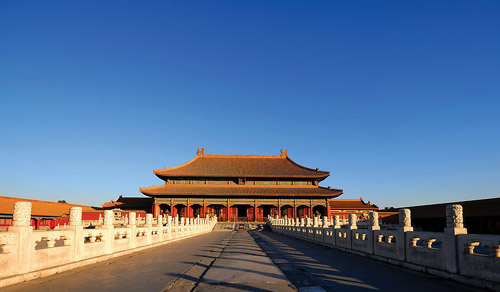Entering Forbidden City
 0 Comment(s)
0 Comment(s) Print
Print E-mail
Xinhua, October 17, 2011
E-mail
Xinhua, October 17, 2011

FROM FORBIDDEN CITY TO PALACE MUSEUM
About 100 years ago, a young man, like Wang, rode a bicycle in the Forbidden City. This young man was China's last emperor, Aisin-Gioro Puyi. He ordered the thresholds of many gates in the palace to be sawed off, so he could ride his bike without any hurdles.
The Forbidden City, built in 1420, was the highest center of power for about 500 years, and occupying the palace was a symbol for ruling China.
Puyi ascended to power in 1908, and was forced to abdicate after the Xinhai Revolution in 1911. According to the articles of favorable treatment reached by the interim government of the Republic of China (ROC) and the Qing court, Puyi was allowed to continue living in the palace temporarily.
In a coup d'etat launched by warlord Feng Yuxiang in 1924, Puyi was forced to leave the Forbidden City. After that, scholars, government officials and some officials of the former Qing court formed the Committee for the Readjustment of the Affairs of the Qing House.
In order to prevent the restoration of the Qing Dynasty, the committee established the Palace Museum.
At the opening ceremony of the Palace Museum on October 10, 1925, the committee said, "From now on, this place belongs to all the people of China."
Although the former imperial palace is commonly referred to as the Forbidden City among foreigners, most Chinese know it as the Palace Museum.
"Turning from the Forbidden City to the Palace Museum is a symbol of epochal change," said Li Gongming, a professor with the art history department of the Guangzhou Academy of Fine Arts.
"From then on, fundamental changes happened to the imperial palace. Its connotation of political power was replaced by civil rights and cultural exchange," Li said.
After dramatic shifts from emperor to a puppet of Japanese aggressors, then from war criminal to ordinary citizen, Puyi revisited the former palace after being granted a special pardon in 1959.
In his autobiography "From Emperor to Citizen," Puyi wrote, "What I found most surprising was that the air of decay and collapse I had known there when I left had disappeared."
"In the imperial garden I saw children playing in the sun and old men sipping tea. I sniffed the spring fragrance of the ancient cypresses and felt that the sun was shining brighter here than it had ever done before. I was sure that the former palace had taken a new lease on life," Puyi wrote.






Go to Forum >>0 Comment(s)